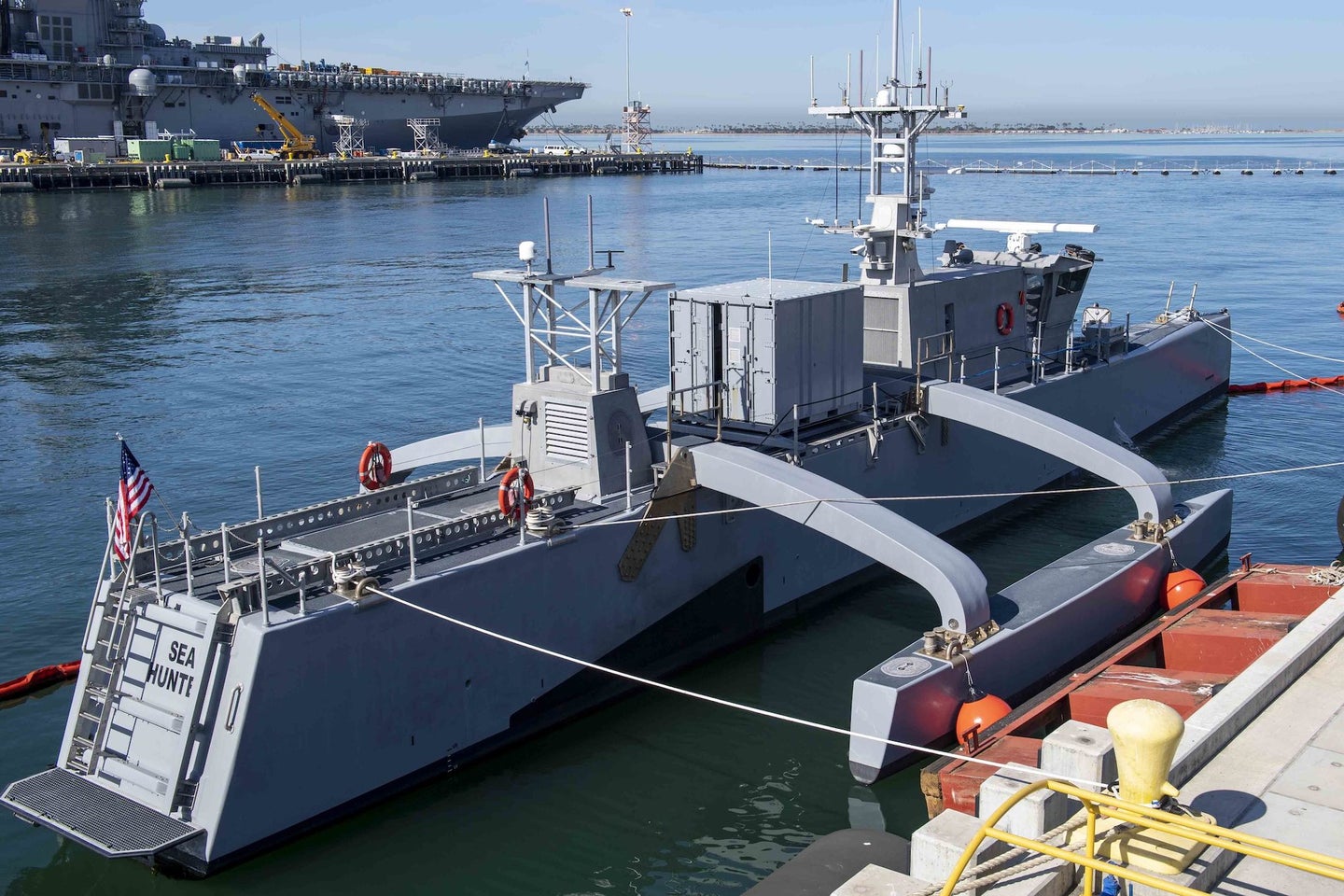The Navy’s testing its new robot ship division in the Pacific this summer
Included are Sea Hunter and Sea Hawk. Here's what the military hopes to learn from the exercise.

Every other year, the US military gathers forces in Honolulu to practice for war in the Pacific. This year, the exercise will feature a formation of entirely uncrewed robot boats. Announced May 13, the newly created “Unmanned Surface Vessel Division One,” or USVDIV One, will let the Navy and the rest of the military practice how to fight war with and alongside giant sea drones. As the military rehearses for a potential future war, it will do so alongside a wholly new category of machine.
“USVDIV One will be a catalyst for innovation as we employ unmanned surface capabilities in the Pacific Fleet,” said Vice Admiral Roy Kitchener, who presided over the ceremony establishing USVDIV One. “The implementation of unmanned systems will increase decision speed and lethality to enhance our warfighting advantage.”
The specific vessels in the divisions include Sea Hunter and Sea Hawk, sister ships built for DARPA’s anti-submarine warfare program. These boats were designed for long continuous operations, with sensors pointed under the sea to find and track submarines hiding in the vastness of the ocean.
[Related: The US Navy launched a missile from a ghost ship. Wait, what? ]
Both Sea Hunter and Sea Hawk previously took part in an April 2021 military exercise, where they were used for scouting, reconnaissance, and intelligence gathering. The admiral in charge of that exercise told C4ISRNET that “one scenario in the exercise required drones to extend the sight of a warship to shoot a missile from long range.”
The Rim of the Pacific exercise run from Honolulu, or RIMPAC, has long been a testing ground for new concepts, as commanders and troops work alongside new machines to see if they will work as planned in simulated combat environments. It was a 2014 exercise that revealed the unsuitability of the Marine Corps’ Legged Squad Support System robot for war, as it proved too loud in exercises to be seen as safe for combat.
It is likely that at RIMPAC, Sea Hunter and Sea Hawk will be used similarly, with sensors used to extend the range of perception for existing weapons based on other vehicles. One merit of uncrewed vehicles is that they can extend the perception of the rest of the fleet without similarly extending the vulnerability of sailors in the same way as a crewed and inhabited vessel.
Beyond the two Sea Hunter-style ships, the uncrewed division will include Nomad and Ranger. While Sea Hunter and Sea Hawk were designed to be uncrewed from the start, Nomad and Ranger are converted from boats used to resupply offshore infrastructure like oil rigs and wind farms. In previous exercises, Ranger was used to fire a missile, demonstrating that uncrewed ships could contribute to firepower as well as scouting and resupply.
Jerry Daley, commander of USVDIV-1, told a media roundtable that the four ships will be dispersed during RIMPAC, and will work with different commanders for both receiving and following orders and also the use of playoads, which will include sensors and could include other capabilities.
If the use of uncrewed ships at RIMPAC is to be a catalyst for a faster, deadlier, more capable Navy, it’s worth taking a step back to examine how that vision and understanding hasn’t yet actually unfolded.
[Related: The Navy’s next robotic ship could be customizable ]
Ultimately, the Navy’s planned method for fighting future wars at sea is by bringing more missiles to the fight, and making sure those missiles hit targets accurately. Uncrewed scouts like the Sea Hunter can offer better information for targeting those weapons. Adapted remotely operated boats like Nomad and Ranger can carry missiles, and use them under human direction or resupply crewed vessels with missile tubes. But if the Navy really wants to augment its existing crewed fleets with more missile tubes, without substantially increasing the cost or demands of sailor labor, it will need to build and bring dedicated missile boats to action.
This was the concept behind the Large Unmanned Surface Vessel, the program that ultimately adapted the Nomad and Ranger from existing vessels. This came after the LUSV’s 2021 budget was drastically scaled back, and with it the promise of building a new ship hull-up for this purpose.
At RIMPAC, the uncrewed ships will allow the Navy to explore how it uses the ships, and even more than that, it will give commanders an opportunity in the field to see what more such vehicles could potentially bring. The RIMPAC exercise will start in June and continue into August. With it, the Navy will be able to see if the robot ships it has on hand offer a promise of the future it wants to work towards, or if the whole vision for robots and humans fighting alongside each other at sea needs to be rethought.
